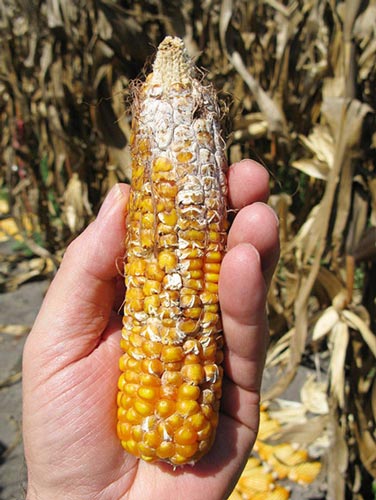By Sam Storr/CIMMYT
 To bolster maize exports to the European Union (EU), Peru is taking measures to ensure its grain is free from mycotoxins, according to CIMMYT maize pathologist Henry Ngugi. “They wanted to establish a testing mechanism because they are trading maize, for which they have to meet strict European Union (EU) standards. They have a project with CIMMYT, which brings them to me” explained Ngugi, who at the request of SENASA, the Peruvian National Agrarian Health Service, led a training course on the subject in Mexico from 21 October to 1 November.
To bolster maize exports to the European Union (EU), Peru is taking measures to ensure its grain is free from mycotoxins, according to CIMMYT maize pathologist Henry Ngugi. “They wanted to establish a testing mechanism because they are trading maize, for which they have to meet strict European Union (EU) standards. They have a project with CIMMYT, which brings them to me” explained Ngugi, who at the request of SENASA, the Peruvian National Agrarian Health Service, led a training course on the subject in Mexico from 21 October to 1 November.
Toxic compounds released by fungal infections in common food grains, mycotoxins spoil 25 percent of global food production, according to the United Nations Food and Agriculture Organization (FAO). Beyond the economic losses they cause, mycotoxins are associated with cancer, stunted growth, birth defects and, on occasion, with mass casualties. Course participants were trained to set up an affordable laboratory with all necessary safety features, and on rapid and affordable methods of analysis for aflatoxins and fumonisins in food commodities. Aflatoxin B1 is the most potent carcinogen known in nature, and fumonisins have been linked to the neural tube defect in embryo formation.
The training emphasized the use of laboratory sessions to prepare trainees to perform the analyses themselves upon returning to their home countries. Although testing for mycotoxins is an established practice in the developed world, a lack of expertise can hinder the participation of other countries in trade. The World Bank believes that EU restrictions on mycotoxins cost Africa US $670 million in lost exports each year. The potential benefits to Peruvian maize farmers and exporters are clear, but Ngugi, an expert with more than 10 years of experience in Toxic compounds released by fungal infections in common food grains, mycotoxins spoil 25 percent of global food production, according to the United Nations Food and Agriculture Organization (FAO).
Beyond the economic losses they cause, mycotoxins are associated with cancer, stunted growth, birth defects and, on occasion, with mass casualties. Course participants were trained to set up an affordable laboratory with all necessary safety features, and on rapid and affordable methods of analysis for aflatoxins and fumonisins in food commodities. Aflatoxin B1 is the most potent carcinogen known in nature, and fumonisins have been linked to the neural tube defect in embryo formation. The training emphasized the use of laboratory sessions to prepare trainees to perform the analyses themselves upon returning to their home countries.

Although testing for mycotoxins is an established practice in the developed world, a lack of expertise can hinder the participation of other countries in trade. The World Bank believes that EU restrictions on mycotoxins cost Africa US $670 million in lost exports each year. The potential benefits to Peruvian maize farmers and exporters are clear, but Ngugi, an expert with more than 10 years of experience in consuming contaminated grains in the last few years,” Ngugi said. “Because of that, this issue does not draw as much attention, but in the long run it could have a lot of consequences.”
Many Latin American staples – such as maize, nuts, chili peppers and beans – are vulnerable to mycotoxin contamination. A 2004 study conducted by the United States Department of Health (USDA) in Guatemala found that half of maize samples collected from local markets would exceed World Health Organization (WHO) guidelines for fumonisin consumption if eaten regularly. “We know the problem exists,” Ngugi said. “But we cannot attract donor funding because if you ask people, they don’t have data.”
 Capacity development
Capacity development 
